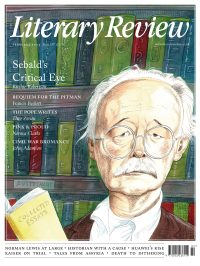Henry Gee
Fantastic Beasts and Where to Find Them
Folklore and Zoology
By Floe Foxon
CRC Press 121pp £29.99
Today there is nowhere on this planet that can fairly be described as pristine. Little wildlife now survives; human beings and our livestock make up 96 per cent of all mammals by mass. All other animals, from aardvarks to zorillas, squeeze into the remaining 4 per cent. Six out of every ten birds are domestic poultry. Human beings sequester between 25 and 40 per cent of the photosynthetic output of all the earth’s plant life. Indeed, the human domination of the earth now exceeds, by several measures, our planet’s capacity to sustain it. It’s therefore a surprise when, now and then, an entirely new creature turns up. And not merely some microbe – there are lots of these – but something big enough to do you damage were it to tread on your foot.
Such was the case when a paper reached the journal Nature from a remote area of Vietnam reporting the discovery of the skin, skull and horns of a kind of large antelope hitherto unrecorded in European science. The biggest surprise is that the paper was written not in 1892 but in 1992. One would have thought that by then scientists had shaken every tree and turned over every stone in search of undiscovered wildlife. Eventually, film of this shy nocturnal creature, known as the saola or Vu Quang ox, turned up, showing it to be very much alive. This was an animal that went out of its way to keep out of the way. Even the locals living in and near the saola’s woodland home didn’t see it very often. But they had seen it before Western scientists, and that is key.
Floe Foxon is a student of cryptozoology, the study of animals known only to science through folktales and legends. Cryptozoology has had a bad rep, and deservedly so, thanks to its propagation of unsubstantiated stories about the existence of Bigfoot, the Yeti and the Loch Ness Monster. Such stories,

Sign Up to our newsletter
Receive free articles, highlights from the archive, news, details of prizes, and much more.@Lit_Review
Follow Literary Review on Twitter
Twitter Feed
It wasn’t until 1825 that Pepys’s diary became available for the first time. How it was eventually decrypted and published is a story of subterfuge and duplicity.
Kate Loveman tells the tale.
Kate Loveman - Publishing Pepys
Kate Loveman: Publishing Pepys
literaryreview.co.uk
Arthur Christopher Benson was a pillar of the Edwardian establishment. He was supremely well connected. As his newly published diaries reveal, he was also riotously indiscreet.
Piers Brendon compares Benson’s journals to others from the 20th century.
Piers Brendon - Land of Dopes & Tories
Piers Brendon: Land of Dopes & Tories - The Benson Diaries: Selections from the Diary of Arthur Christopher Benson by Eamon Duffy & Ronald Hyam (edd)
literaryreview.co.uk
Of the siblings Gwen and Augustus John, it is Augustus who has commanded most attention from collectors and connoisseurs.
Was he really the finer artist, asks Tanya Harrod, or is it time Gwen emerged from her brother’s shadow?
Tanya Harrod - Cut from the Same Canvas
Tanya Harrod: Cut from the Same Canvas - Artists, Siblings, Visionaries: The Lives and Loves of Gwen and Augustus John by Judith Mackrell
literaryreview.co.uk